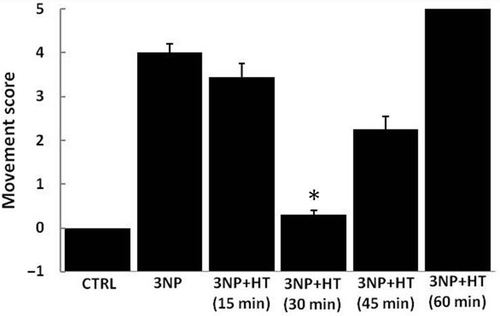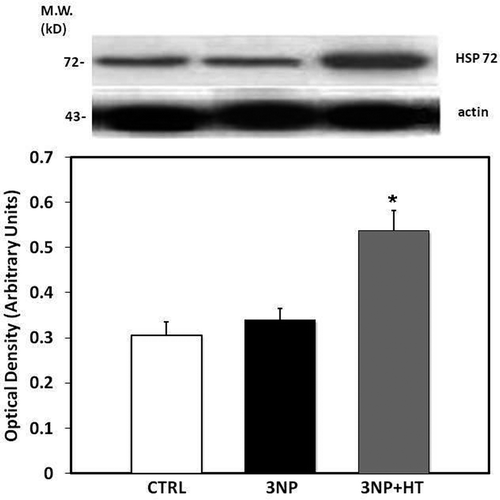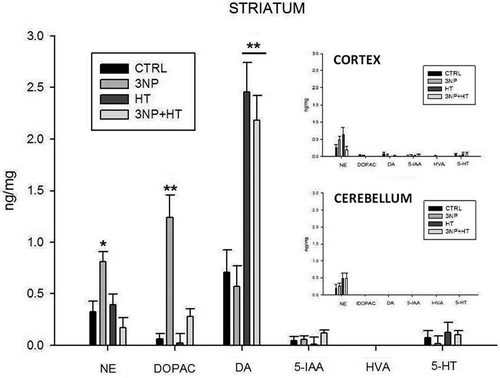Figures & data
Figure 1. Total movement score and the effect of thermal treatment in control rats (CTRL), rats treated with 3 NP (20 mg/Kg, i.p., 3 doses 0,12 and 24 h) and rats treated with 3-NP but subject to a heat pretreatment (WBH 15, 30, 45 and 60 minutes). Rats where subject to hyperthermia and injected with a first dose of 3-NP 16 hours later; two more doses of 3-NP were applied with an interval of 12 hours each. Groups were evaluated 6 hours after the last injection. Each column represents the mean ± SEM for five independent experiments (n = 10 animals by group). *p < 0.05 versus all the groups except control group (CTRL).

Figure 2. Carbonyl protein amount in cerebellum, cortex and striatum of rats treated with 3-NP (20 mg/Kg, i.p., 3 doses 0,12 and 24 h) and the effect of whole body hyperthermic pretreatment (WBH 42°C, 30 minutes). Groups: Control (CTRL); rats treated with 3-nitropropionic acid (3NP); rats treated with 3NP and previously subjected to whole body hyperthermia 30 minutes (3NP + HT); rats subject to whole body hyperthermia 30 minutes (HT). The protein amount was determined processing a parallel sample blank without 2,4-dinitrophenylhydrazine (DNPH) for each sample and constructing a standard curve with bovine serum albumin (BSA) dissolved in guanidine 6M. The carbonyl content was reported as nmol/mg of protein. Values are means ± SEM. n = 10. *p < 0.05 versus CTRL ** p < 0.01 versus CTRL and 3NP Cortex.

Figure 3. Hydroxyl radical-dependent oxidative stress in the striatum of rats treated with 3-NP (20 mg/Kg, i.p., 3 doses 0,12 and 24 h)-and the effect of whole body hyperthermic pretreatment (WBH 42°C, 30 minutes). Sodium salicylate (200 mg/Kg i.p.) was administered to all groups except saline solution (N) 2 h after the last 3-NP injection. The groups: control group (CTRL), group of rats treated with 3-nitropropionic acid (3NP), group of rats subject to heat pretreatment and then treated with 3-NP (3NP + HT) and the group of rats treated only with whole body hyperthermia 30 minutes (HT). Values are means ± SEM. n = 10. * p < 0.01 3NP versus CTRL; # versus 3NP + HT; & versus HT.

Figure 4. Representative Western blot of HSP 72 expression and densitometric analysis derived from striatum samples in the control, group (CTRL), in rats treated with 3-nitropropionic acid 20 mg/Kg, i.p, 3 doses, 0, 12 and 24 h (Group 3-NP) and in rats subject to heat pretreatment (WBH 42°C, 30 minutes) and then treated with 3-NP (Group 3-NP + HT). The Western blot of actin was carried out to assure constant amounts of protein in each lane. Means of three experiments ± SEM. *p < 0.05 versus CTRL.

Figure 5. Determination of biogenic amines in the striatum, cerebellum and cortex of rats treated with 3-NP (20 mg/Kg, i.p., 3 doses, 0,12 and 24 h) and the effect of whole body hyperthermia pretreatment (WBH 42°C, 30 minutes). NE, norepinephrine; DOPAC, 3,4-dihydroxyphenylacetic acid; DA, dopamine; 5-HIAA, 5-hydroxyindole-3-acetic acid; HVA, homovanillic acid; 5-HT, 5-hydroxytryptamine. Groups: Control (CTRL); rats treated with 3-nitropropionic acid (3NP); rats treated with 3NP plus whole body hyperthermia 30 minutes (3NP + HT) and rats treated only with whole body hyperthennia 30 minutes (HT). Values are means ± SEM. *p = 0.014 versus CTRL. ** p < 0.001 versus CTRL.

Table I. Concentrations of dopamine (DA), 3,4-dihydroxyphenylacetic acid (DOPAC), and DA turnover (DOPAC/DA) in the striatum of rats treated with 3-nitropropionic acid, with and without whole body hyperthermia (WBH). (WBH 30 min and 3-NP 20 mg/Kg i.p. 3 doses 0, 12 and 24 h.)